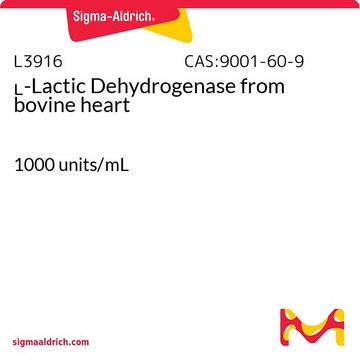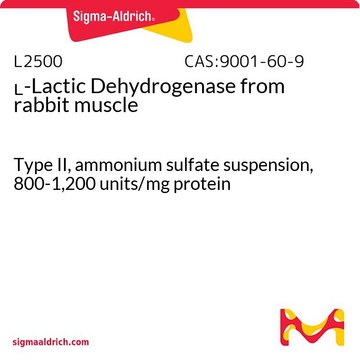SAE0049
L-Lactat-Dehydrogenase (LDHA)
from human, recombinant, expressed in E. coli, aqueous solution
Synonym(e):
L-Lactat-Dehydrogenase, rekombinant aus E. coli, (S)-Lactat: NAD+ Oxidoreduktase, Milchsäuredehydrogenase, rekombinant
About This Item
Empfohlene Produkte
Biologische Quelle
human
Qualitätsniveau
Rekombinant
expressed in E. coli
Form
aqueous solution
Lagerbedingungen
(Keep container tightly closed in a dry and well-ventilated place)
Farbe
colorless
UniProt-Hinterlegungsnummer
Versandbedingung
dry ice
Lagertemp.
−20°C
Angaben zum Gen
human ... LDHA(3939)
Suchen Sie nach ähnlichen Produkten? Aufrufen Leitfaden zum Produktvergleich
Allgemeine Beschreibung
The gene LDHA (L-lactate dehydrogenase A chain) is mapped to human chromosome 11p15. It is a subunit of lactate dehydrogenase.In particular, lactic dehydrogenase A (LDHA) is mainly found in skeletal muscle, and for that reason is known as the M subunit. This recombinant form of LDHA has a C-terminal histidine-tag.
Anwendung
Biochem./physiol. Wirkung
Einheitendefinition
Physikalische Form
Lagerklassenschlüssel
10 - Combustible liquids
WGK
WGK 1
Flammpunkt (°F)
Not applicable
Flammpunkt (°C)
Not applicable
Analysenzertifikate (COA)
Suchen Sie nach Analysenzertifikate (COA), indem Sie die Lot-/Chargennummer des Produkts eingeben. Lot- und Chargennummern sind auf dem Produktetikett hinter den Wörtern ‘Lot’ oder ‘Batch’ (Lot oder Charge) zu finden.
Besitzen Sie dieses Produkt bereits?
In der Dokumentenbibliothek finden Sie die Dokumentation zu den Produkten, die Sie kürzlich erworben haben.
Kunden haben sich ebenfalls angesehen
Unser Team von Wissenschaftlern verfügt über Erfahrung in allen Forschungsbereichen einschließlich Life Science, Materialwissenschaften, chemischer Synthese, Chromatographie, Analytik und vielen mehr..
Setzen Sie sich mit dem technischen Dienst in Verbindung.










